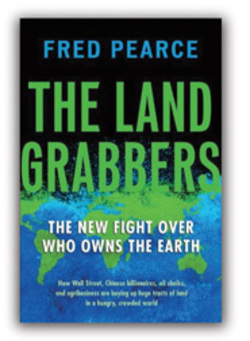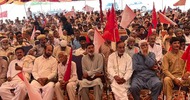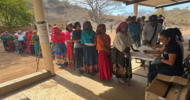Conservation Magazine | 12.03.2012
Hungry for Land
When the super-wealthy scoop up huge plots of land worldwide, what’s left behind?
Gaia Vince reviews The Land Grabbers by Fred PearceWhen Madagascan President Marc Ravalomanana was ousted in March 2009, a major factor in his new unpopularity was the deal he had made with South Korea’s Daewoo corporation, effectively handing over 1 million hectares of Madagascar’s best agricultural land. The firm planned to use a South African workforce to grow 5 million metric tons of corn a year in addition to cultivating 120,000 hectares of palm oil, mainly for export to land-poor Korea to ensure its food security. With two-thirds of the Madagascan population living below the poverty line of less than US$ 0.64 a day and more than 500,000 relying on food aid, the deal provoked outrage from the international community. The 99-year land lease was quickly repealed by incoming Madagascan President Andry Rajoelina.
The media attention focused on the Madagascan “land grab” was unusual and short-lived. In fact, such land deals are widespread, not just in the island state but globally—across the poorest parts of Africa, Asia, Latin America, and the Caucasus. Some estimates put the amount of land procured by foreigners at more than 200 million hectares. This rush to buy up vast tracts of what’s often claimed as “unused” land is being described as the “new colonialism,” threatening the livelihoods of millions of peasant farmers. In his latest book, The Land Grabbers, veteran environmental writer Fred Pearce conducts a thorough and enlightening exposé of these murky deals.
How we exploit the world’s land in the new global economy, whether through conservation, farming, or pastoralism, will surely prove one of the defining issues of this century.
Pearce employs the same engaging and perspicacious style regarding the land-grab issue that readers will be familiar with from his previous investigations into the global water crisis (When the Rivers Run Dry), climate change (The Last Generation and With Speed and Violence), and the population crisis (Peoplequake). His prolificacy—Pearce authored ten books between 2005 and 2010—doesn’t seem to impact the thoroughness of his research. In Land Grabbers, Pearce visits multiple sites in dozens of countries, taking the reader on a journey from the swamps of Ethiopia to the financial centers of the West.
We learn how commodities speculators, from 2007 onward, created a bubble in food prices that drove staples from wheat to rice out of the reach of poor people, leading to food riots and contributing to the bloody civil disturbances of the “Arab Spring.” Land speculators are accelerating land grabs, particularly in Africa, which they claim is home to 60 percent of the world’s uncultivated land. The promise of fortunes to be made there by buying cheap land is such that one former Goldman Sachs employee assures would-be investors, “We could be moronic and not grow anything and still make money over the next decade.”
Naturally, most investors do plan to harvest their land, and Pearce introduces readers to a broad spectrum of players who are cultivating food crops, timber, rubber, palm oil, sugar, and biofuels. They’re anxious to make the biggest profit in the shortest amount of time. That means vast, mechanized operations—agribusiness, scaled on the American Midwest model. Most are welcomed to the country and given free access to water, plus tax and infrastructure incentives by corrupt governments or by states trying to develop their economies and agriculture with help from rich nations.
Not all investors are in it for profit, however. Some are working to help feed the anticipated global population of 9 billion, to help Africans feed themselves, even to protect the land from waste and native wildlife poachers. Others among these new colonialists are buying up vast swathes of land to conserve it, either as pristine wilderness—in the case of green buyers in Patagonia and East Africa—or as hunting and tourism businesses.
What all these land grabbers have in common, Pearce shows, is the requirement that the land be cleared of people—other than workers brought in by the new owners, of course. And therein lies the biggest problem. Who actually owns the land? In many cases, rich foreign investors buy (or are given) “unoccupied,” state-owned, or common lands. But as Pearce eloquently explains, there is almost nowhere on the planet—certainly no fertile lands—that is unoccupied. In reality, these lands are important farming, grazing, hunting, or gathering sites for the world’s poorest people; they often have villages on them which are frequently bulldozed away.
Foreign land investors are very rarely in it for the long haul; often they sell the land within five years of purchase. As a result, Pearce shows us, they have little interest in the long-term sustainability of a site and, in a matter of months, can devastate a site’s soil, biodiversity, water quality, and forests. The indigenous owners, however, have in most cases developed over generations the extraordinary land-management techniques, from shifting agriculture to nomadic herding, that allow them to harvest a site productively and sustainably over generations. These people are gated out of their lands when the land grabbers arrive, explains Pearce—with heartbreaking examples.
Conservationists in some parts of the world are beginning to recognize that indigenous people do not necessarily threaten biodiversity and, in many cases, manage it well. But there is a long way to go before the hundreds of thousands of dispossessed people thrown out of national parks find justice. Pearce fears that the new international credits for forest conservation, under the Reducing Emissions from Deforestation and Forest Degradation (REDD+) scheme, will lead to the evictions of many thousands of hitherto unmolested indigenous forest tribes as governments try to cash in on avoided deforestation.
With such limited land available and so many mouths to feed, many would argue that large corporations should use the world’s land in the most modern, technologically advanced way possible. Pearce disagrees, pointing out that profits and goods from all of these land-grabbing enterprises are almost entirely transferred out of the host countries, including through nonpayment of taxes. The poor and hungry, who mostly live in the host countries, are not served by these agricultural squatters; local people, who lose their land and grazing rights in the process, are often far worse off. The solution for a hungry and crowded world, Pearce suggests, lies in supporting smallholder farmers to improve their production rates, and buying from them. It is in their interests—and ours—to conserve the land.
Gaia Vince is a London-based freelance journalist specializing in science, the environment, and social issues. http://wanderinggaia.com/














